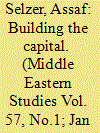| Srl | Item |
| 1 |
ID:
177684


|
|
|
|
|
| Summary/Abstract |
The Declaration of Independence of the State of Israel makes no mention of the country’s aspirations regarding its borders; neither does it mention the name of the state’s capital. The absence of these features was due to the state of war that the country faced at the time of the declaration, as well as the fact that according to the Partition Plan (UN Resolution 181), Jerusalem was supposed to come under international control. This article discusses Israel’s actions in the area of Jerusalem under its control. In December 1949, it was officially decided to transfer the institutions of government to Jerusalem. The state institutions were initially scattered around the city, but a government compound began to be developed later. The article will focus on the development of this compound, presenting the decisions that were implemented in order to turn it into a capital within a city.
|
|
|
|
|
|
|
|
|
|
|
|
|
|
|
|
| 2 |
ID:
120724


|
|
|
|
|
| Publication |
2013.
|
| Summary/Abstract |
In a world still dominated by a geopolitical system of territorial states, one tool in the state- and nation-building repertoire is the strategy of moving a capital from one city to another, and to an ostensibly more 'central' location of a geometrically conceived territory. From Ankara to Brasília, the technique has been used in a variety of places around the world, and Kazakhstan's new capital since 1997, Astana, is one more recent iteration. Taking a Foucauldian approach to analysing political technologies of government, the author examines the strategy of the centrally located city and considers how it has been instrumental to simultaneously producing a 'state effect' and a 'territory effect' in newly independent Kazakhstan. Part of a larger mixed-methods study, this article draws on a diverse range of methods, including data from interviews, participant observation, textual analysis, focus groups and a country-wide survey.
|
|
|
|
|
|
|
|
|
|
|
|
|
|
|
|